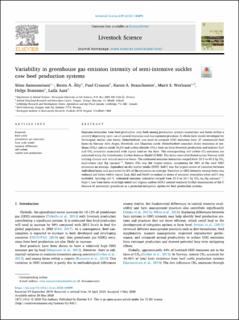| dc.contributor.author | Samsonstuen, Stine | |
| dc.contributor.author | Åby, Bente Aspeholen | |
| dc.contributor.author | Crosson, Paul | |
| dc.contributor.author | Beauchemin, Karen A. | |
| dc.contributor.author | Wetlesen, Marit Smith | |
| dc.contributor.author | Bonesmo, Helge | |
| dc.contributor.author | Aass, Laila | |
| dc.date.accessioned | 2021-02-11T09:28:49Z | |
| dc.date.available | 2021-02-11T09:28:49Z | |
| dc.date.created | 2021-02-03T17:06:58Z | |
| dc.date.issued | 2020-05-20 | |
| dc.identifier.citation | Livestock Science. 2020, 239 . | en_US |
| dc.identifier.issn | 1871-1413 | |
| dc.identifier.uri | https://hdl.handle.net/11250/2727329 | |
| dc.description.abstract | Emission intensities from beef production vary both among production systems (countries) and farms within a country depending upon use of natural resources and management practices. A whole-farm model developed for Norwegian suckler cow herds, HolosNorBeef, was used to estimate GHG emissions from 27 commercial beef farms in Norway with Angus, Hereford, and Charolais cattle. HolosNorBeef considers direct emissions of methane (CH4), nitrous oxide (N2O) and carbon dioxide (CO2) from on-farm livestock production and indirect N2O and CO2 emissions associated with inputs used on the farm. The corresponding soil carbon (C) emissions are estimated using the Introductory Carbon Balance Model (ICBM). The farms were distributed across Norway with varying climate and natural resource bases. The estimated emission intensities ranged from 22.5 to 45.2 kg CO2 equivalents (eq) (kg carcass)−1. Enteric CH4 was the largest source, accounting for 44% of the total GHG emissions on average, dependent on dry matter intake (DMI). Soil C was the largest source of variation between individual farms and accounted for 6% of the emissions on average. Variation in GHG intensity among farms was reduced and farms within region East, Mid and North re-ranked in terms of emission intensities when soil C was excluded. Ignoring soil C, estimated emission intensities ranged from 21.5 to 34.1 kg CO2 eq (kg carcass)−1. High C loss from farms with high initial soil organic carbon (SOC) content warrants further examination of the C balance of permanent grasslands as a potential mitigation option for beef production systems. | en_US |
| dc.language.iso | eng | en_US |
| dc.publisher | Elsevier B.V. | en_US |
| dc.rights | Navngivelse 4.0 Internasjonal | * |
| dc.rights.uri | http://creativecommons.org/licenses/by/4.0/deed.no | * |
| dc.title | Variability in greenhouse gas emission intensity of semi-intensive suckler cow beef production systems | en_US |
| dc.type | Peer reviewed | en_US |
| dc.type | Journal article | en_US |
| dc.description.version | publishedVersion | en_US |
| dc.rights.holder | © 2020 The Authors | en_US |
| dc.source.pagenumber | 12 | en_US |
| dc.source.volume | 239 | en_US |
| dc.source.journal | Livestock Science | en_US |
| dc.identifier.doi | 10.1016/j.livsci.2020.104091 | |
| dc.identifier.cristin | 1886453 | |
| dc.relation.project | Norges forskningsråd: 233683 | en_US |
| dc.relation.project | Norges forskningsråd: 244836 | en_US |
| dc.source.articlenumber | 104091 | en_US |
| cristin.ispublished | true | |
| cristin.fulltext | original | |
| cristin.qualitycode | 1 | |

